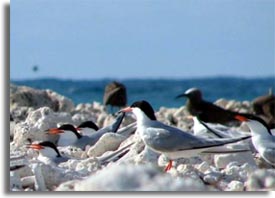 |
|
FWC biologists and the National Park
Service used plastic decoys and recorded bird calls to lure these
nesting roseate terns to a site in the Dry Tortugas. (FWC photo by
Sharyn Hood) |
After four hurricanes left a tiny island off the coast of Key West
submerged in the Atlantic in 2005, Florida Fish and Wildlife Conservation
Commission (FWC) biologists studying the roseate tern knew there would be
trouble for the threatened seabird. So, the scientists hatched a plan.
Pelican Shoal, once covered in coral rubble and sand, had been the perfect
habitat for the hundreds of roseate terns that migrated there each summer.
The quarter-acre island was one of only two places in Florida where the
birds could lay their eggs. FWC biologists watched closely each summer as
the birds returned to Pelican Shoal from South America, laid their eggs and
raised their chicks for about a month before flying south again.
Hurricanes Dennis, Katrina, Rita and Wilma left Pelican Shoal, which was 5
miles south of Boca Chica Naval Air Station, 1 to 2 feet underwater. FWC
biologists knew that when the colony of roseate terns returned in summer
2006, they might not be able to find suitable habitat and possibly wouldn’t
be able breed.
Desperate for a solution, FWC biologists Ricardo Zambrano and Sharyn Hood
decided to try “social attraction” techniques, such as using decoys and
recorded bird calls to attract the returning roseate terns to another
possible habitat –- the Dry Tortugas National Park. The area was also
impacted by the hurricanes, which cleared vegetation, replacing it with
sand and coral rubble, creating an ideal spot for the roseate terns.
With the cooperation of the National Park Service, Zambrano and Hood
planted 40 plastic Roseate Tern decoys at the park in April. They put a
solar-powered compact disc player, amplifier and water-resistant speakers,
constantly playing a recording of roseate tern calls, next to the decoys.
In July, FWC and National Park Service personnel discovered 33 nests of
roseate terns the site. On July 27, they found 42 adults and 16 chicks. FWC
and the National Park Service will continue placing social attraction
equipment until roseate terns permanently establish the site as a nesting
area.
"Good news is important when it comes to imperiled species, and it is great
when we get to share a success story,” said FWC Executive Director Ken
Haddad. “I am thrilled to report that because of the diligence and
ingenuity of FWC staff and with help from the National Park Service, the
threatened roseate tern has a better chance of survival."
|
Please join us in our
Discussions forums with topics covering Wildlife Rehabilitation,
Birding, Backyard Wildlife and More.
|